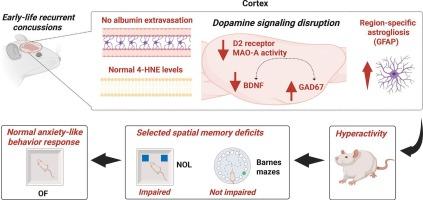Recurrent spaced concussions in adolescent rats disrupt cortical dopaminergic markers and induce behavioral hyperactivity and impaired object location memory
IF 2.8
3区 医学
Q2 NEUROSCIENCES
引用次数: 0
Abstract
Repeated concussions during critical stages of brain development can lead to lasting neural and behavioral changes. This study characterized the consequences of recurrent, spaced concussions using a clinically relevant adolescent Wistar rat model. Male rats were subjected to ten spaced concussions via a weight-drop model during adolescence (P42–P73) and subsequently underwent neurobehavioral, neurochemical, and histological analysis. Behaviorally, the concussion protocol induced hyperactivity in the open-field test and produced specific deficits in the Novel Object Location task; in contrast, performance was unimpaired in the Novel Object Recognition and Barnes Maze tests. These behavioral outcomes were accompanied by disruptions to cortical dopaminergic and GABAergic systems, including reduced dopamine D2 receptor levels, lower monoamine oxidase-A activity, and decreased brain-derived neurotrophic factor (BDNF) and increased gamma-aminobutyric acid decarboxylase 67 (GAD67) expression. Concurrently, glial fibrillary acidic protein (GFAP) expressions were elevated in specific corticolimbic regions. Importantly, these alterations occurred without severe injury markers, such as loss of consciousness or albumin extravasation. Our findings demonstrate that spaced concussive events during adolescence are sufficient to produce distinct behavioral and neurochemical deficits. This work highlights dopaminergic dysfunction as a key etiological factor and potential therapeutic target for impairments following repeated concussions in the developing brain.

青春期大鼠复发性间隔性脑震荡破坏皮质多巴胺能标记物,诱发行为多动和客体定位记忆受损
在大脑发育的关键阶段反复脑震荡会导致持久的神经和行为改变。本研究使用临床相关的青春期Wistar大鼠模型来描述复发性间隔性脑震荡的后果。雄性大鼠在青春期通过体重下降模型遭受10次间隔脑震荡(P42-P73),随后进行神经行为、神经化学和组织学分析。在行为上,脑震荡方案在开放场地测试中诱发了多动症,并在新物体定位任务中产生了特异性缺陷;相比之下,在新物体识别和巴恩斯迷宫测试中的表现没有受到损害。这些行为结果伴随着皮质多巴胺能和gaba能系统的破坏,包括多巴胺D2受体水平降低,单胺氧化酶a活性降低,脑源性神经营养因子(BDNF)减少和γ -氨基丁酸脱羧酶67 (GAD67)表达增加。同时,胶质原纤维酸性蛋白(GFAP)在特定皮质边缘区表达升高。重要的是,这些改变发生时没有严重的损伤标志,如意识丧失或白蛋白外渗。我们的研究结果表明,青春期间隔震荡事件足以产生明显的行为和神经化学缺陷。这项工作强调了多巴胺能功能障碍是发育中的大脑反复脑震荡后损伤的关键病因和潜在治疗靶点。
本文章由计算机程序翻译,如有差异,请以英文原文为准。
求助全文
约1分钟内获得全文
求助全文
来源期刊

Neuroscience
医学-神经科学
CiteScore
6.20
自引率
0.00%
发文量
394
审稿时长
52 days
期刊介绍:
Neuroscience publishes papers describing the results of original research on any aspect of the scientific study of the nervous system. Any paper, however short, will be considered for publication provided that it reports significant, new and carefully confirmed findings with full experimental details.
 求助内容:
求助内容: 应助结果提醒方式:
应助结果提醒方式:


